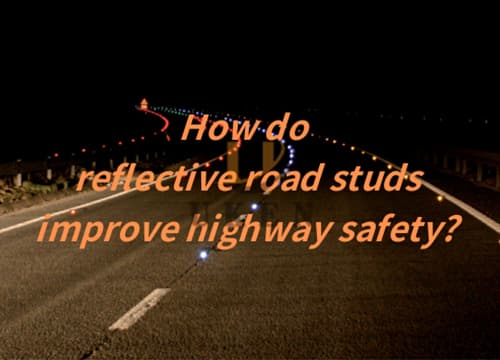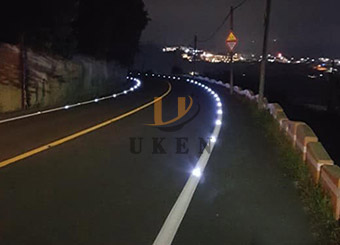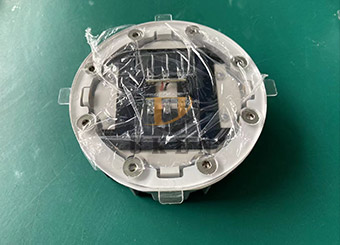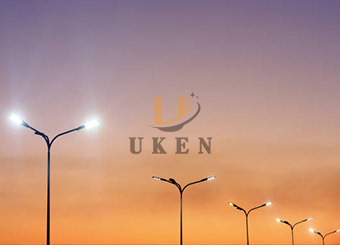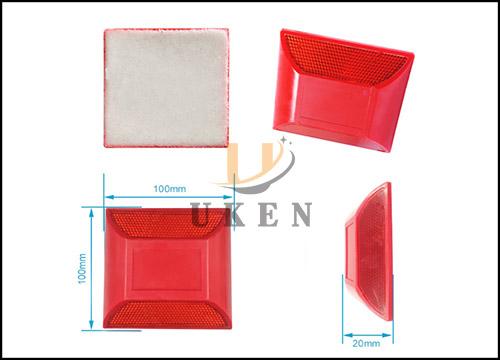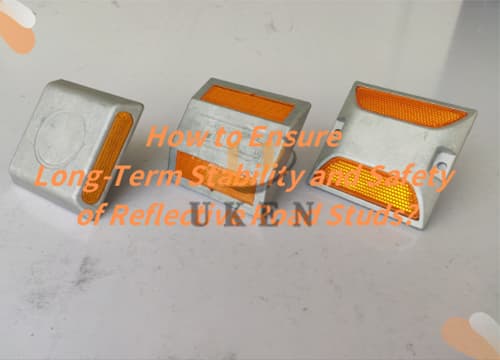With the continuous rise of modern traffic flow, the importance of road safety facilities has become more and more prominent. Traditional road studs rely on vehicle light reflection to achieve the warning function, in the night, rain, fog, sand and dust and other harsh environments, its visual distance is greatly reduced, it is difficult to meet the safety needs of complex road conditions. Against this backdrop, solar-powered LED road studs, with their active light-emitting characteristics and intelligent technology, have become a key force in the innovation of road safety facilities.
Basic concept
Solar LED road studs are road safety marking facilities that integrate solar power and LED active light-emitting technology. Different from the traditional passive reflective road studs, it collects light energy through the built-in solar panels, converts it into electricity and stores it in batteries, and then automatically lights up the LED lamps at night to realise continuous active illumination.
Functional characteristics
The Stud is mainly used for road outline marking, hazardous area warning and traffic guidance, and can be automatically switched on and off and adjusted in brightness through the intelligent control system in the absence of external power supply, which significantly improves the visibility of the road at night and the safety of driving.
Solar Panel
The solar panels are made of monocrystalline or polycrystalline silicon, with a photoelectric conversion efficiency of 18%-22%. Even in low-light environment, such as cloudy days or early morning, it can effectively absorb light energy. The surface of the solar panels is coated with a special coating that makes them UV resistant, waterproof and dustproof, so they are suitable for all kinds of outdoor environments.
Energy Storage Battery
Common energy storage batteries include lithium batteries and nickel-metal hydride batteries. Lithium batteries have high energy density and long cycle life (more than 1,000 times of charging and discharging), which are suitable for scenarios with high endurance requirements; nickel-metal hydride batteries have lower cost and better low-temperature performance, which are suitable for use in cold regions. Intelligent battery management system (BMS) monitors the battery status in real time, optimises the charging and discharging strategy, and prolongs the service life of the battery.
LED Light Emitting Unit
High-brightness LED beads as the light-emitting core, with low energy consumption, long life (up to 50,000 hours), fast response speed. Supporting red, yellow, blue and other colour configurations, some products can be programmed to achieve dynamic light-emitting modes such as flashing, gradient, etc., to enhance the warning effect.
Control Module
Built-in light control and time control chip to achieve intelligent lighting control. Light control module by sensing the ambient light intensity, automatically triggering the road studs in the sunset when open, closed at sunrise; time control function supports the customisation of working hours and brightness adjustment strategy, to further optimise the energy efficiency.
Light energy collection
During the day, solar panels receive solar radiation, light energy into electricity. Its working principle is based on the photovoltaic effect: when photons irradiate the semiconductor material, the electrons get energy to produce electron – cavity pairs, the electric field under the action of the formation of electric current, energy conversion.
Electrical energy storage
The converted energy is stored in the battery through a charge management circuit, and the BMS system monitors the battery voltage, temperature and other parameters in real time to avoid over-charging and over-discharging, ensuring safe and efficient energy storage.
Night power supply
When the ambient light becomes dark in the evening and reaches the set threshold, the control module triggers the LED light-emitting unit to start. The battery releases power to drive the LED lights to continue to emit light, providing illumination and warning for the road.
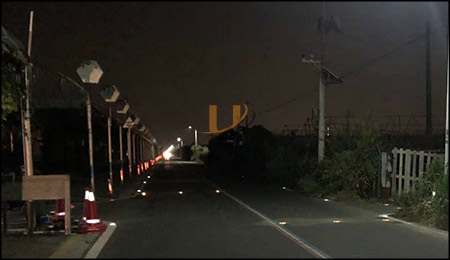
Light Sensor Control
The light-sensing element is like the ‘eyes’ of the road studs, sensing changes in environmental brightness in real time. When the light intensity is lower than 10Lux (about dusk light), the Stud is automatically turned on; when it is higher than 50Lux (about early morning light), it is automatically turned off, realising unattended intelligent operation.
Brightness Adjustment
Some high-end products support adaptive brightness adjustment. Late at night when the traffic flow is reduced, the road stud automatically reduces the brightness to 30% -50%, to ensure safety while extending the range; encountered in rainy and foggy weather, the system automatically raises the brightness to enhance the penetration.
High visibility
In the night or visibility of less than 50 metres of bad weather, solar LED road studs with active light-emitting properties, visible distance up to more than 200 metres, far more than the traditional reflective road studs of 50-80 metres. The continuous arrangement of light-emitting Studs clearly outlines the road, helping drivers to anticipate road conditions in advance.
Dynamic warning effect
Supports a variety of light-emitting modes, such as high-frequency flashing 2-3 times per second, alternating red and yellow colours, and so on. Research has shown that dynamic illumination can increase driver’s attention by 40%, which can effectively reduce the rate of accidents on dangerous roads such as sharp turns and construction zones.
Zero carbon emission
A single solar-powered LED road stud can reduce carbon dioxide emissions by 36.5kg per year, which is equivalent to planting two adult trees. Large-scale application can significantly help the transport sector to achieve carbon neutrality.
Low energy design
The LED beads consume only 0.5-1W of power, and combined with a highly efficient energy storage system, they can work continuously for 3-5 rainy days on a single full charge. Compared to active lighting installations that require an external power supply, annual energy savings can be up to 365 kWh/thousand lamps.
Easy Installation
Two types of installation are available: embedded and adhesive. Embedded studs are fixed by punching holes and are suitable for new roads. Stick-on studs use high-strength glue and can be installed in 30 minutes, which is suitable for temporary roads or renovation projects.
Low Maintenance
LEDs and batteries are designed to last more than 5 years, so routine maintenance only requires regular cleaning of the solar panels. Intelligent failure warning system can report abnormalities in real time, a single Stud replacement time of less than 10 minutes, significantly reducing labour and material costs.
Lane Separation
In the main lane of the highway, every 15-20 metres to install red solar LED road studs, a clear division of lane boundaries. When driving at night, the continuous red light band can effectively reduce the illegal lane changing accidents and improve the driving order.
Special Road Warning
In dangerous areas such as sharp bends, long downhill slopes, tunnel entrances and exits, yellow flashing road studs are deployed. For example, at curves, the studs flash at a frequency of 1Hz to warn drivers to slow down in advance, which can reduce the speed of vehicles through the curve by 12%.
Non-motorised Lane Marking
Blue LED Studs are installed along the edges of urban non-motorised lanes to visually differentiate them from white pavement markings. When riding at night, the continuous illumination of the studs can remind motor vehicles to pay attention to avoid, to ensure the safety of non-motorised vehicles.
Pavement Warning
In schools, hospitals and other crowded areas of the pedestrian crossing, set up white flash road Stud. When pedestrians pass through, the Stud automatically flashes at high frequency, prompting vehicles to slow down and give way, significantly improving the safety of crossing the street.
Car park guidance
In car parks, green LED studs are used for marking the boundaries of parking spaces and guiding driving routes. Vehicle owners can quickly find the empty space through the light-emitting studs, and at the same time, reduce scratching accidents and improve parking efficiency.
Scenic Road Decoration
In tourist attractions, colourful LED road studs can be customized with patterns and light-emitting modes. Such as in the bamboo forest pathway arrangement gradient green light road studs, creating a poetic atmosphere; in the steps edge installation of yellow warning road studs, both aesthetic and safety features.
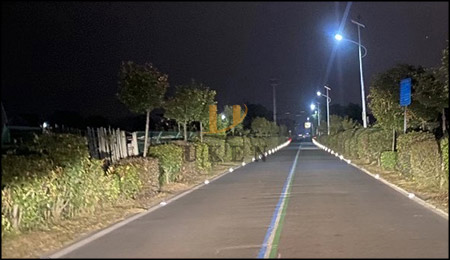
Performance comparison
| Compare Projects | Solar LED Road Stud | Traditional reflective road studs |
| Lighting method | Active light | Passive reflective |
| Visibility | All-weather high visibility | Reliance on vehicle lights, poor performance in bad weather |
| Environmental adaptability | IP68 protection level, high and low temperature resistance |
Susceptible to rain, dust and sand |
| Energy consumption | Solar self-sufficiency | None (no active energy consumption) |
| Warning effect | Dynamic light, strong attraction | Static reflection, single effect |
Cost comparison
| Cost Type | Solar LED Road Stud | Traditional reflective road studs |
| Initial investment | About 80-150 yuan/piece | 20-50 Yuan/piece |
| 10-year operating costs | Low (zero electricity bill, low maintenance) | Medium (needs to be replaced regularly) |
| Comprehensive Benefits | Long-term economic benefits | Low cost performance |
Pre-preparation
Use a laser range finder to determine the installation point, to ensure that the spacing is uniform. Clean the road surface of the installation area, remove oil, dust. Prepare electric drill, screwdriver, special glue, studss and other tools and materials.
Installation Steps
Embedded: Drill holes (depth 5-8cm) → Put in the base → Pour concrete → Install the main body of the Stud → Seal and waterproof.
Sealing and waterproofing.
Paste type: Apply high strength glue → press the Stud to the road surface → leave it to cure for 24 hours.
Commissioning test
Use simulated light source to test the light control function of the Stud, check whether the LED light colour, brightness and flashing mode are normal. Test the battery voltage by multimeter to ensure that the energy storage system works well.
Daily inspection
Check the integrity of the Studs every week, and use a soft cloth to wipe the dust on the surface of the solar panels. Record and deal with problems such as loose Studs and LEDs not lighting up in a timely manner.
Professional Maintenance
Use professional equipment to check the battery capacity every quarter, and consider replacing it when the capacity drops to 80%. Comprehensively check the wiring connection and waterproof performance every year, and replace the aging parts.
Troubleshooting
No light: check the battery connection, LED beads are damaged, replace the faulty parts.
Flashing abnormality: reset the control module programme, if ineffective, then replace the control board.
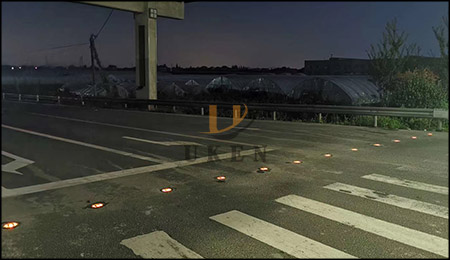
Transportation strategy
National ‘’ 14th Five-Year ‘ modern comprehensive transport system development plan ’ clearly put forward the promotion of intelligent transport facilities. Many governments on the use of solar energy LED road studss project to give 10% -30% of the financial subsidies to accelerate the popularity of the product.
Carbon Neutral Targets
The ‘double carbon’ policy requires energy saving and emission reduction in the field of transport, solar LED road studss as a zero-carbon facilities, was included in the green transport key promotion catalogue, market demand is expected to grow at an average annual rate of 25%.
Application of new materials
Breakthroughs in the research and development of chalcogenide solar panels are expected to increase the photovoltaic conversion efficiency to more than 30%, further reducing the size of the Stud. New nano-coating materials can enhance the anti-wear and anti-corrosion properties of road studs and extend their service life.
Intelligent upgrade
The application of Internet of Things technology makes the Stud with remote monitoring function. Managers can view the working status and fault location of the Stud in real time through mobile phone APP, realising intelligent operation and maintenance. In the future, the Stud may be integrated with environmental monitoring sensors, providing data support for traffic management.
Solar LED road studs with active light, energy saving and environmental protection, intelligent and convenient core advantages, is reshaping the standard of road safety facilities. Whether it is the efficient guidance of the highway, or the fine management of urban roads, its application value has been verified by the market. With the dual drive of policy support and technological innovation, solar LED road studs will play a greater role in the construction of intelligent transport. We look forward to more traffic projects to introduce this innovative product, and jointly build a safe, green and intelligent modern transport system.
